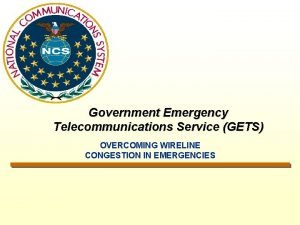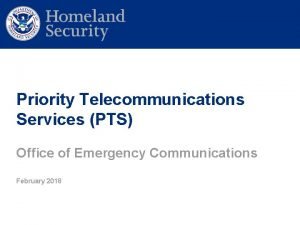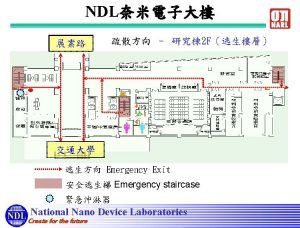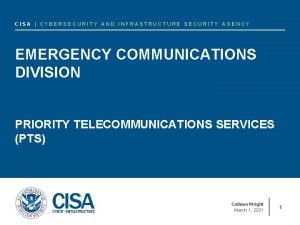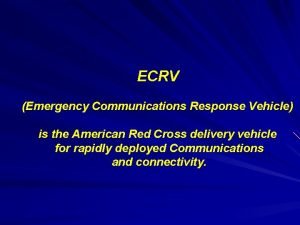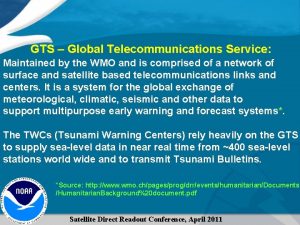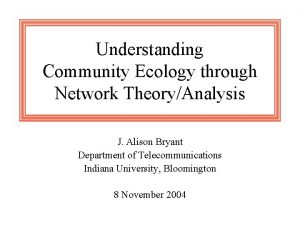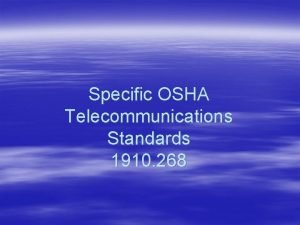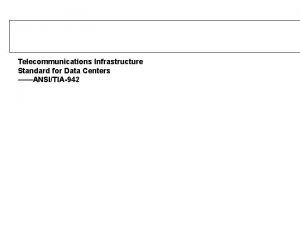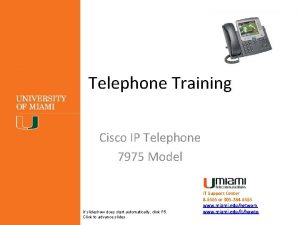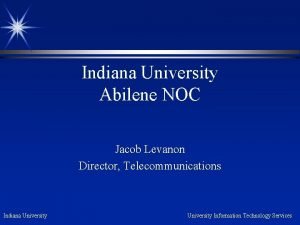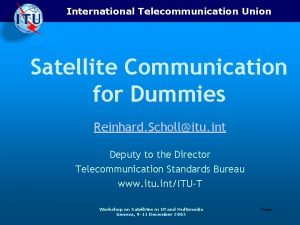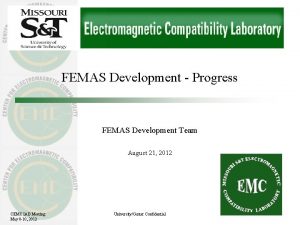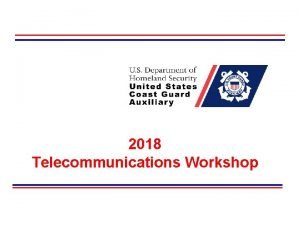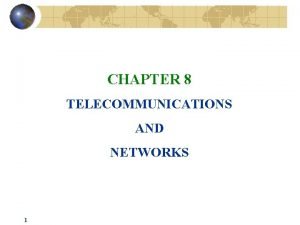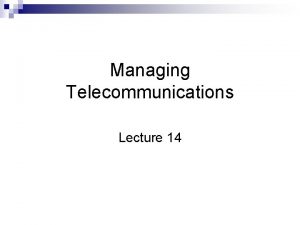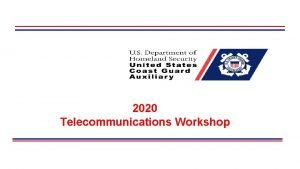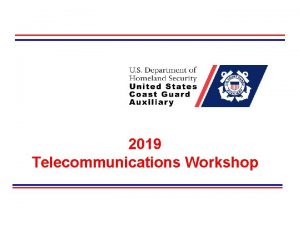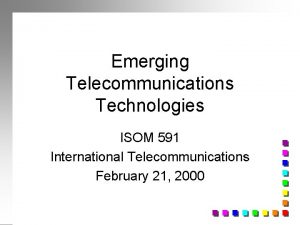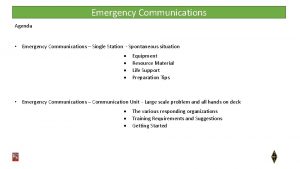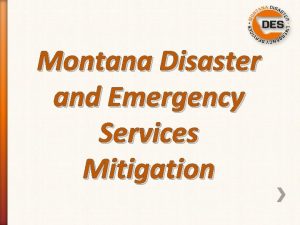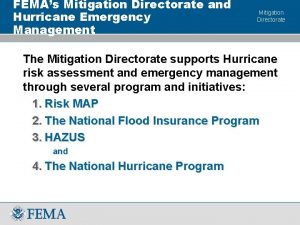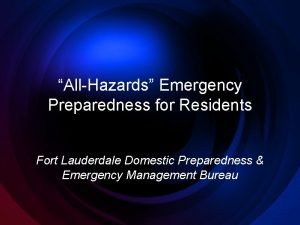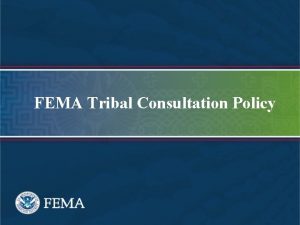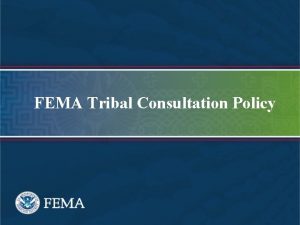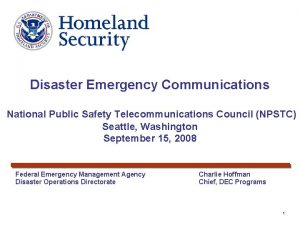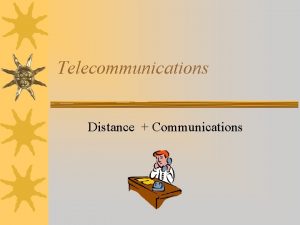EMERGENCY COMMUNICATIONS Telecommunications technologies to support FEMAs allhazards



















- Slides: 19

EMERGENCY COMMUNICATIONS Telecommunications technologies to support FEMA’s all-hazards mission 1

Emergency Communications ¨ FEMA uses a variety of communications services and systems to support activity in several interrelated but separate functional areas: – Day-to-day information system requirements such as voice, video, data, E-mail, Internet access, and National Emergency Management Information System (NEMIS) – Pre-disaster communications capabilities for Federal, State, and local emergency management personnel in mitigation and preparation efforts – Telecommunications during and immediately following a disaster to perform preliminary damage assessment and resource requirements analysis 2

Emergency Communications – Telecommunications to support consequence management activities such as Disaster Field Office (DFO) setup, restoration coordination, and resource prioritization – Emergency command control functions for special events 3

Pre-Crisis Systems ¨ FEMA INTEGRATED NETWORK – facilities linked with high-speed terrestrial circuits that provide integrated voice, data, and video network service – Routers connect FEMA facilities and provide access to the internet – Private Branch Exchange (PBX) systems provide voice capability through FEMA’s Integrated Network, Public Network, and Federal Telephone System (FTS) – Disaster Field Offices are quickly added to architecture to provide a robust field operating environment 4

FEMA Integrated Network Presidio Bothell, WA Altern- Kansas City, MO ate Denver, CO Region 6 (+NTC) Chicago, IL Thomasville, GA Frankfort, KY Atlanta, Ga Hyattsville NPSC Philadelphia, PA Mt. Weather Headquarters Emmitsburg, MD Olney, MD Albany, NY Elkridge, MD Maynard, MA FIA Boston, MA Jessup, MD Lanham, MD New York, NY 5

Pre-Crisis Systems ¨ FEMA NATIONAL WARNING SYSTEM (NAWAS) – NAWAS is a civil defense and day-to-day emergency warning response and coordination system – 24 -hour voice only hotline system that provides capability to warn Federal, State, and local governments of impending disasters – NAWAS circuits are controlled by two warning centers; a primary and an alternate – Warning points (nodes) are interconnected with leased, nonswitched terrestrial voice circuits – Approximately 2, 200 warning points 6

NAWAS ALASKA HAWAII Warning Centers FEMA Regional Centers State Warning Points Main Lines - WC’s /Regions ANWC THOMASVILLE, GA Region to State WP Lines State/Local WP Lines 7

Pre-Crisis Systems ¨ FEMA NATIONAL RADIO SYSTEM (FNARS) – Voice and data High Frequency (HF) radio system – Links State Emergency Operations Centers and FEMA Sites – Interfaces with a wide variety of other Federal and civilian HF radio systems – Common radio frequencies used to support emergency situations – Consists of more than 120 fixed, mobile, and transportable HF radio stations – Supports Emergency Alerting System (EAS) primary entry points – Radio Amateur Civil Emergency Services (RACES) provides emergency communications at State and local facilities – Currently more than 500, 000 Amateur Radio operators in the U. S. 8

FNARS 9

Pre-Crisis Systems ¨ Ku. BAND SATELLITE – FEMA maintains two (2) Ku. Band satellite earth stations for use as entry points for mobile Ku. Band satellite elements – Provides access to FEMA Integrated Network via satellite – Provides backup to FEMA terrestrial circuits ¨ Sky. Cell SYSTEM – Provides backup voice dial-tone and radio dispatch capability to key facilities – Provides satellite-based emergency command control for special events 10

Crisis Systems ¨ Emergency Response Teams deploy to affected area to coordinate Federal consequence management effort – – – – Cellular, Paging, & PCS Ku. Band Satellite - 6 Mobile Elements MSAT Technology (Sky. Cell) with Radio Dispatch INMARSAT Land Mobile Radio Low Earth Orbit (ORBCOMM) High Frequency Radio 11

Crisis Systems ¨ Disaster Field Office (DFO) is setup as a temporary facility to support field aspects of consequence management (communications, logistics, mass care, food, energy, transportation, energy, etc. ). – Temporary nodes of FEMA Integrated Voice and Data Network – Interface to FEMA Network provided by terrestrial circuits or Ku. Band satellite – Wireless Office Concept • Micro-Cellular Phone System • Wireless LAN – LOS and Laser systems for campus environment 12

Sky. Cell System 13

Low Earth Orbit Satellite System 14

Mobile Ku. Band Satellite System 15

Emergency Operating Vehicle 16

Emergency Operating Vehicle 17

Emergency Operating Vehicle 18

Emergency Operating Vehicle 19
 Advantages of star topology
Advantages of star topology Government emergency telecommunications service
Government emergency telecommunications service Pts
Pts National emergency communications plan
National emergency communications plan Cisa emergency communications division
Cisa emergency communications division Emergency communications response vehicle
Emergency communications response vehicle Mdm support technologies in dss
Mdm support technologies in dss Pediatric emergency life support
Pediatric emergency life support Signal words
Signal words Venture capital telecommunications
Venture capital telecommunications Gts telecommunications
Gts telecommunications Department of telecommunications
Department of telecommunications Telecommunications, the internet, and wireless technology
Telecommunications, the internet, and wireless technology Difference lan wan
Difference lan wan Osha telecommunications standards
Osha telecommunications standards Rfp for telecommunications services
Rfp for telecommunications services Telecommunications infrastructure standard for data centers
Telecommunications infrastructure standard for data centers Department of telecommunications
Department of telecommunications Iu telecommunications
Iu telecommunications Telecommunications for dummies
Telecommunications for dummies

